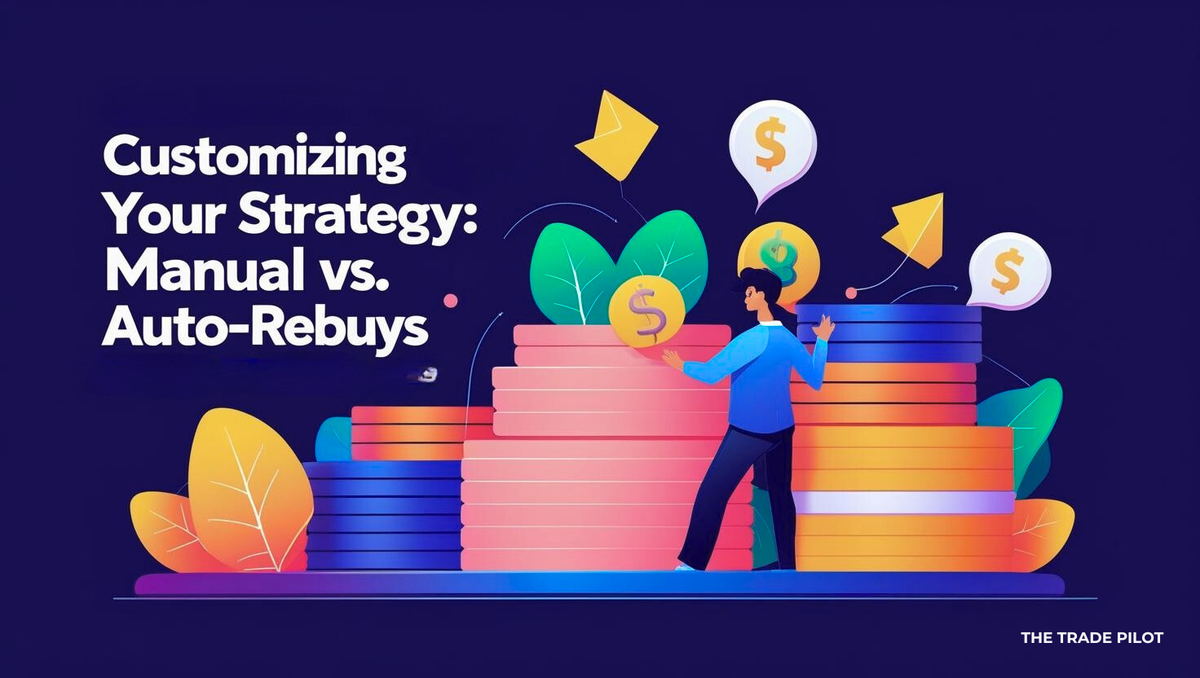Should you trust the bot to handle rebuys or take control yourself? This article breaks down the pros, cons, and configurations of manual vs. auto-rebuys in The Trade Pilot.
One of the standout features of The Trade Pilot is the ability to customize how your bot reinvests in positions through rebuys. Whether you're using a Dollar-Cost Averaging (DCA) approach or a Grid strategy, rebuys play a crucial role in maximizing your potential profit and managing price drops. But a key question arises: should you allow the bot to handle rebuys automatically, or should you make them manually?
Let’s explore the differences, benefits, and ideal use cases of both manual and automatic rebuys, so you can tailor your strategy with confidence.
What Are Rebuys?
Rebuys are additional purchases made when the price of a cryptocurrency drops after your initial buy. They help lower your average purchase price and improve the chances of selling at a profit. In The Trade Pilot, rebuys are highly customizable and can be configured according to your preferences.
You can set:
- The number of allowed rebuys
- Rebuy trigger (price drop % or time interval)
- Base for rebuy value (initial order or total invested)
- Growth rate and level multiplier
- Whether rebuys should be merged into one position or treated separately
- Manual or automatic execution
Automatic Rebuys
With automatic rebuys enabled, The Trade Pilot will execute rebuys on your behalf based on the conditions you define. For example, you can set a rebuy to occur every 7 days (time-based)—this is the only valid option for DCA-style investing. Price-based triggers are better suited for grid strategies.
This approach ensures:
- Timely execution without your involvement
- Consistency with your pre-defined strategy
- Ideal for hands-off investors or those using structured DCA or grid strategies
Pros:
- Completely passive experience
- Ideal for long-term strategies
- Reduces emotional decision-making
- Takes advantage of market dips quickly
Cons:
- Less control over timing
- Could use more funds than expected if many rebuys trigger in a short time
Manual Rebuys
When automatic rebuys are turned off, no additional investments are made unless you initiate them manually. This gives you full control over when and how to deploy more capital.
Manual rebuys are more suited for traders who want to:
- React to specific market news or signals
- Assess each situation individually
- Avoid rebuys in highly volatile or uncertain markets
Pros:
- Full control over each rebuy decision
- Avoids spending during extreme downtrends
- Ideal for short-term, active traders
Cons:
- Requires frequent monitoring
- Easy to miss opportunities if not attentive
Strategy Comparison: Manual vs. Auto
- Use Auto-Rebuys if you’re following a DCA strategy or want to automate grid trading. It’s perfect for users who want to stay consistent and emotion-free in their investing approach.
- Choose Manual Rebuys if you prefer active management, want full control, or are cautious about spending in falling markets.
The Trade Pilot gives you the flexibility to toggle between manual and automatic modes at any time. You can start with automation and switch to manual when you want to take control—or do the opposite.
Final Thoughts
Customizing your rebuy method is about aligning your strategy with your risk tolerance, availability, and trading goals. Auto-rebuys offer powerful automation for those who prefer to set and forget, while manual rebuys provide control and adaptability.
Whichever method you choose, always monitor your fund usage, especially when using aggressive configurations. Be mindful of how many rebuys you allow, and consider your available balance. And don’t forget to review your performance regularly to adjust your setup for better results.
Once you're satisfied with your rebuy configuration, the next step is to turn the bot on and let it handle the market for you.

